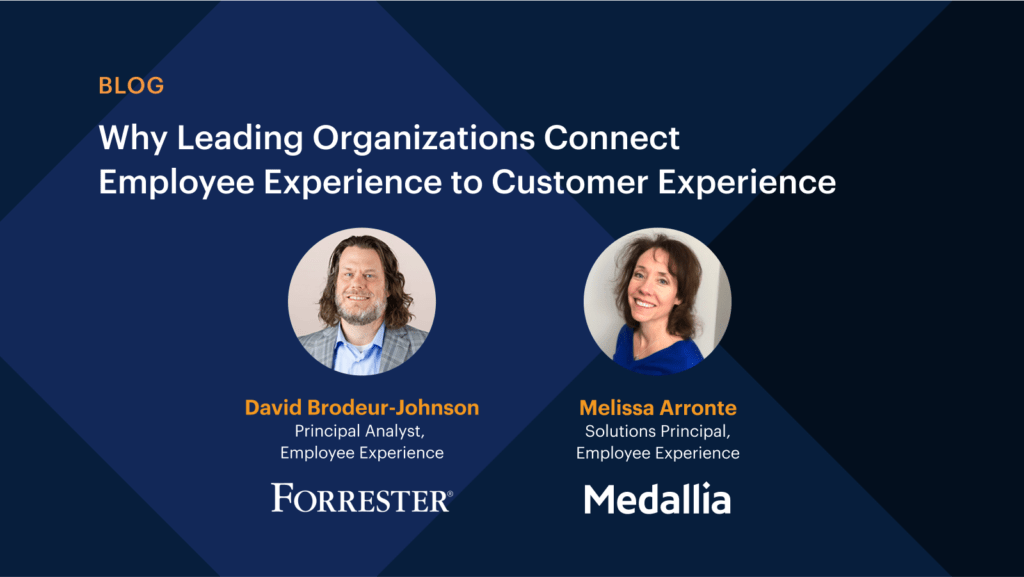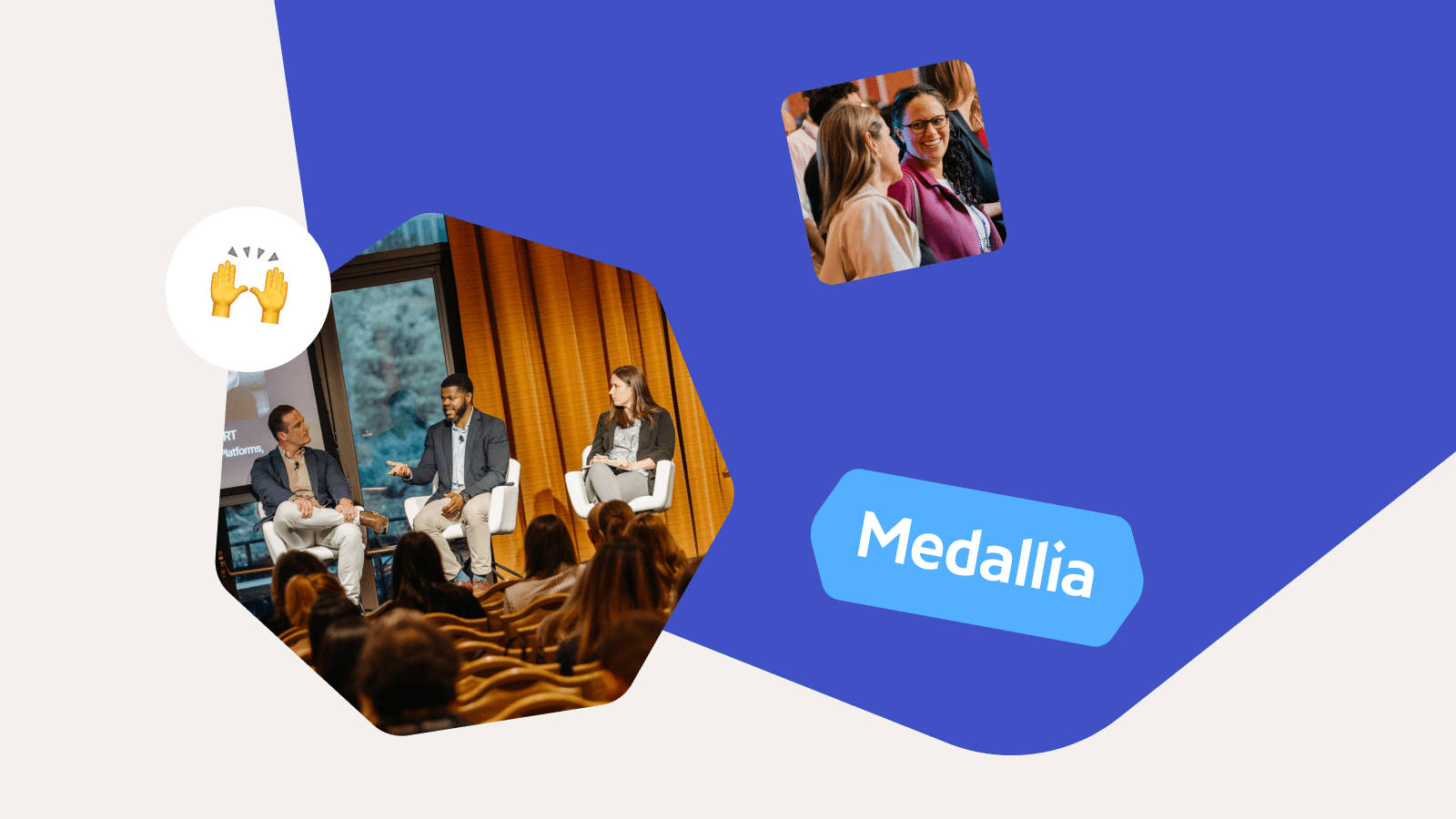Why Leading Organizations Connect Employee Experience to Customer Experience
December 12, 2022
Customer Experience
If a business wants to improve customer experience, examining and improving employee experience is where to start. Forrester’s David Brodeur-Johnson and Medallia’s Melissa Arronte explain the significant impact on customer loyalty and retention when employees feel their voices are heard.
Customer experience (CX) and employee experience (EX) shouldn’t feel like strangers within an organization. In fact, quite the opposite — they should feel like best friends. Where one goes, the other follows.
Successful organizations don’t only prioritize both. Instead, the leading brands in every industry also focus on connecting CX to EX and vice versa. As it turns out, companies achieve greater business outcomes when employees are encouraged and empowered to use their voices to drive positive change across the organization — thus creating better experiences for customers.
It can only be done when organizations evolve beyond annual engagement surveys and start continuously listening to and understanding their employees, then taking meaningful action based on their feedback.
David Brodeur-Johnson, Principal Analyst at Forrester, recently joined Melissa Arronte, Solutions Principal at Medallia, for an in-depth conversation on the connection between employee experience and customer experience.
Here are the highlights from their discussion, which also spotlights best practices for an organization to follow.
The Link Between EX & CX, Featuring Forrester’s David Brodeur-Johnson & Medallia’s Melissa Arronte
What is the link between customer experience (CX) and employee experience (EX)?
Melissa Arronte: People often see the link between employee experience and customer experience as simply “happy employees equal happy customers.” However, this is not the case. Retailers, for example, can make employees happy by eliminating weekend and evening shifts, but customers wouldn’t be happy with reduced shopping time during the most popular hours. One side is happy, and the other is not.
Customer issues frequently begin with an issue rooted in employee experience, one that the employee is unable to overcome and is then exposed to the customer.
Take a look at this example: A bank employee comes to work to help customers achieve financial success, and the banker derives meaning and fulfillment from helping customers. As bankers work to help customers, they encounter obstacles such as time-consuming processes, outdated guidelines, or manual steps that should be automated. Obstacles like these impede a banker’s ability to help customers, resulting in slower service or errors that ultimately frustrate the customer.
Empowering employees to identify and suggest solutions for these types of obstacles is the most direct way EX impacts CX.
David Brodeur-Johnson: The answer to this question could fill a book, but the late Herb Kelleher, founder of Southwest Airlines, said it best: “If the employees come first, then they’re happy. A happy employee treats the customer well. The customer is happy, so they keep coming back, which pleases the shareholders. It’s not one of the enduring green mysteries of all time, it’s just the way it works.”
In the last couple of decades since, countless studies and business leaders have reinforced this view. In our own research, we found that the three most important levers of customer experience when interacting with a company are effectiveness, ease, and emotion. In other words: Did they get done what they set out to do? Was it easy to do it? And how were they made to feel? When companies get this right, they enjoy higher customer retention and loyalty.
And for employee experience, the three levers are empowerment, inspiration, and enablement. When they get this right for their people, they enjoy higher employee engagement. Engaged employees create better products and fully apply their talents and skills to serve customers better. So, the link is higher employee engagement, which leads to greater customer loyalty.
What are some of the hurdles organizations need to overcome to bring CX and EX programs together?
Melissa: The primary hurdle is in our thinking. We often think of EX and CX in silos. In employee experience, we tend to focus on the things that HR can do rather than thinking that every area of the company has some impact on employee experience. In CX, we often focus on adjusting journeys, products, policies, and more, but often without input from employees.
We also often focus on different outcomes for EX and CX, such as employee retention and customer loyalty respectively, instead of aligning on common outcomes. If we bring a single focus to both EX and CX, such as delivering on our brand promise to our customers, we can align the experience and clearly define what it means to be customer-focused and support employees.
Here’s an example: An organization might promise customers that they can trust an insurance company to protect them. Everyone understands our customer-centric goal is trust and not just being friendly or fast and convenient. You’ve prioritized trust and, in doing so, must design customer and employee experiences to maximize this value. This means putting policies in place that show our employees we trust them.
EX and CX connected are about two humans interacting. People naturally want a positive, helpful interaction. We want to create the conditions to make this easy; however, all too often we unintentionally make it difficult with our processes and policies. Identify this friction and remove any barriers to facilitate better human-to-human interactions.
David: While we can identify the connections between a great employee experience and a great customer experience, we must remember that the two areas have different goals and underlying psychology. So, the biggest barrier is understanding and honoring these differences so that they can be managed effectively by different parts of the organization yet integrated effectively to create great experiences for both customers and employees.
Customers have experiences with organizations they do business with in relatively brief, infrequent moments — so there is a lot riding on those moments, and the practice of CX is much about getting each of those moments to be the best it can be. In contrast, EX is something that employees experience every day, for several hours a day, often for years at a time. And the mosaic of things that affect their emotional state and willingness to give the best of themselves is rich and varied. Whether they trust their managers, whether they feel like they have the resources to succeed in their work, and how well their own values align with the values of their organizations are all significant dimensions that take specialized tools and expertise to measure and improve.
What questions you ask in a survey, how you identify the people to survey, what systems you need to integrate with to automate a survey program, how to tap into and analyze enterprise social data for sentiment, and what science you use to understand the results are all very different between CX and EX practices and tools.
With this understanding, you can build credibility with executive leaders and others in the organizations you must influence to drive EX forward. This leads us to the second big hurdle: building awareness and broad support for EX with HR, sales, operations, IT, corporate communications, legal, compliance, and others.
EX touches every department, and they each play a key role in making lasting improvements. To accept that and do their part, these other leaders need a common understanding based on science and data, but they also need the insight that an effective EX listening strategy can bring to help guide their thinking so that they can make more informed decisions that foster great EX.
How does employee listening and analytics support the EX–CX connection?
Melissa: The use of more frequent, less structured employee listening in combination with signal data that offers insight into the employee experience makes it significantly easier to understand where employees need more enablement or empowerment to deliver for customers. Simple comparisons between teams, departments, and locations with high versus low customer scores with the wealth of EX data allow us to see what EX conditions are different between high- and low-performing groups.
We can even use this data to create alerts for teams at risk of receiving low customer scores and predictive models to understand employees at risk of turnover or burnout to intervene to reduce it proactively.
David: Historically, companies have not had the data or the scientific expertise to design a comprehensive listening program that can link EX to business results, including CX, in ways that are credible and repeatable. But that is changing as more ways of gathering data from more sources and assembling it into a more complete picture become available, and the power that these insights hold comes into focus.
Forrester has published research demonstrating that one of the things that sets customer-obsessed organizations apart is that they are insights-driven — meaning that they gather a lot of data and use it in innovative ways to gain greater insight into customer and employee experiences to make them better.
More importantly, employees are often in the best position to see and understand how customer experience can be better, and as more organizations have found success with mining this rich source of insights, it’s leading more organizations to do the same.
How are organizations attributing return on investment (ROI) to the impact of EX on CX? How can the organization measure employee success and its relationship to customer loyalty and revenue?
Melissa: We’re fortunate to now have platforms that easily bring together employee and customer data for insights and action. We can see a customer issue in a survey or other signals and analyze employee data to understand what is driving the customer issue or ask employees the cause of the issue. Then we can directly measure outcomes such as improved customer satisfaction, increased sales, or reduced cost as a result of applying the employee solution to the customer issue.
With both EX and CX data in one platform, you have many ways of assessing the impact of an EX change — such as removing an employee obstacle to deliver service for customers — on CX through analysis of customer comments, customer sentiment, customer calls about issues, and beyond.
David: Unfortunately, measuring the direct ROI of EX investments on CX is difficult because so much of it seems intangible. But it’s important to remember that when we say intangible, what we mean is that it’s hard to measure — not that it’s any less real.
What seems to work is to begin with a set of CX metrics such as customer satisfaction or retention, and explore different EX investment scenarios to see how each is likely to influence the CX metrics and set priorities accordingly. Then, circle back after making the investments to see if the CX results were achieved and how much of that is attributable to them.
Understand & Meet Employee Needs to Earn Better Business Outcomes
CX and EX go hand-in-hand. Whether you’re just launching programs or are further along with established programs in motion, it’s important to keep this in mind. What you’ll find is that, when customer feedback skews negatively for any particular reason, the root is often related to an issue your own employees are facing but can resolve.
Check out our guide, Expert Insights: How to Build an Employee Experience Program, to discover what leaders with decades of experience launching and advancing EX efforts say it takes to be successful.










